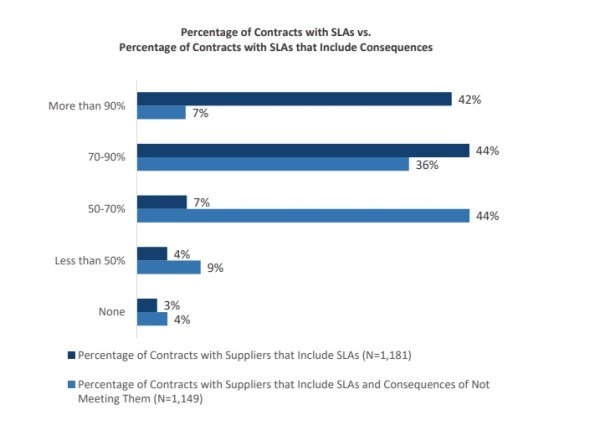
A service level agreement (SLA) defines the specifications, quality, and cost of a good or service
being provided by a supplier to a buyer. SLAs help to provide transparency about what the buyer
expects from the supplier and protects all parties in the event of a dispute or a disagreement.
In the absence of any documented consequences, when there is a problem with a product or service received, organizations can only rely on the supplier’s desire to receive any performance incentives that may be in the contract. If these are absent, then the buyer can only rely on the supplier’s integrity and goodwill. That level of trust may be high enough in cases where the buyer and the supplier have a strategic, mutually-beneficial relationship with each other, but in more transactional relationships, the absence of consequences can make an SLA effectively toothless.
What a Good SLA Looks Like
Just having the SLA in place is not enough. APQC has found that many organizations still
have opportunities to include the consequences of not meeting the SLA expectations in their
contracts with suppliers. Just seven percent of organizations include consequences for more
than 90 percent of their contracts with SLAs, while slightly more than a third (36 percent) include
consequences in 70 to 90 percent of their contracts
While consequences are important for an SLA, formulating the right consequences is a balancing
act. You want to be clear, but also avoid being too heavy handed. For example, organizations
committed to social procurement (that is, driving positive social change through procurement
spending) could be working against that goal if SLA consequences include heavy fines and
onerous penalties for a supplier from a historically underrepresented group. If working with
smaller and more diverse suppliers is a value, you’ll want to take that into account and make
sure you don’t prevent them from doing business with you because your terms are too punitive.
Striking the right balance can be a challenge, especially since there is no one-size-fits-all set of
consequences that apply to every SLA. Effective penalties will vary from one contract and one
relationship to another, which means you’ll need at least some knowledge of your supplier’s
culture and priorities to design consequences that are effective and that make sense for the
relationship.
As you work to strike the right balance for penalties, don’t forget to include rewards for meeting
or exceeding SLA targets. Rewards could mean achieving or maintaining preferred seller status,
getting a higher share of the buyer’s spend in the future, or getting a monetary bonus in
addition to the contract payment.
Learn more about how to have the correct consequences to create clarity in your Service Level Agreements (SLAs).
To continue the conversation, follow Marisa on Twitter at @MB_APQC or connect with her on LinkedIn.
